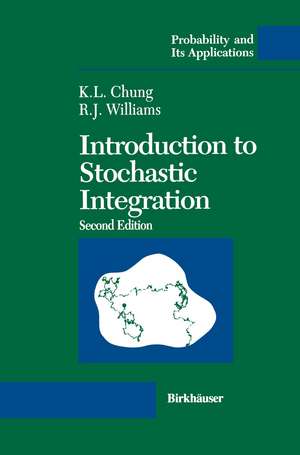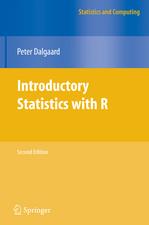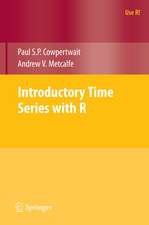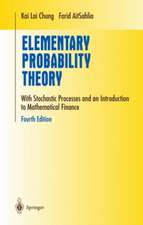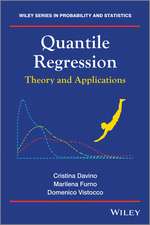Introduction to Stochastic Integration: Probability and Its Applications
Autor Kai L. Chung, Ruth J. Williamsen Limba Engleză Paperback – 30 sep 2011
Din seria Probability and Its Applications
-
 Preț: 392.60 lei
Preț: 392.60 lei -
 Preț: 395.09 lei
Preț: 395.09 lei - 18%
 Preț: 739.00 lei
Preț: 739.00 lei - 18%
 Preț: 783.35 lei
Preț: 783.35 lei - 15%
 Preț: 640.24 lei
Preț: 640.24 lei - 18%
 Preț: 948.47 lei
Preț: 948.47 lei -
 Preț: 391.99 lei
Preț: 391.99 lei - 18%
 Preț: 1399.43 lei
Preț: 1399.43 lei - 20%
 Preț: 569.10 lei
Preț: 569.10 lei - 15%
 Preț: 691.08 lei
Preț: 691.08 lei -
 Preț: 385.08 lei
Preț: 385.08 lei - 18%
 Preț: 1123.19 lei
Preț: 1123.19 lei -
 Preț: 393.52 lei
Preț: 393.52 lei - 15%
 Preț: 646.62 lei
Preț: 646.62 lei -
 Preț: 461.65 lei
Preț: 461.65 lei - 18%
 Preț: 787.91 lei
Preț: 787.91 lei - 15%
 Preț: 702.41 lei
Preț: 702.41 lei - 15%
 Preț: 557.27 lei
Preț: 557.27 lei -
 Preț: 382.36 lei
Preț: 382.36 lei - 18%
 Preț: 1120.99 lei
Preț: 1120.99 lei - 18%
 Preț: 786.49 lei
Preț: 786.49 lei - 15%
 Preț: 655.78 lei
Preț: 655.78 lei - 18%
 Preț: 785.68 lei
Preț: 785.68 lei -
 Preț: 385.25 lei
Preț: 385.25 lei - 15%
 Preț: 701.90 lei
Preț: 701.90 lei - 18%
 Preț: 915.79 lei
Preț: 915.79 lei - 18%
 Preț: 1345.87 lei
Preț: 1345.87 lei - 18%
 Preț: 733.65 lei
Preț: 733.65 lei -
 Preț: 384.31 lei
Preț: 384.31 lei - 15%
 Preț: 582.80 lei
Preț: 582.80 lei -
 Preț: 361.42 lei
Preț: 361.42 lei - 15%
 Preț: 709.09 lei
Preț: 709.09 lei - 15%
 Preț: 644.95 lei
Preț: 644.95 lei - 15%
 Preț: 648.24 lei
Preț: 648.24 lei - 18%
 Preț: 897.02 lei
Preț: 897.02 lei - 15%
 Preț: 528.13 lei
Preț: 528.13 lei - 15%
 Preț: 727.59 lei
Preț: 727.59 lei - 15%
 Preț: 470.88 lei
Preț: 470.88 lei - 18%
 Preț: 1001.81 lei
Preț: 1001.81 lei - 18%
 Preț: 954.14 lei
Preț: 954.14 lei -
 Preț: 392.60 lei
Preț: 392.60 lei - 15%
 Preț: 652.31 lei
Preț: 652.31 lei - 18%
 Preț: 1396.43 lei
Preț: 1396.43 lei - 18%
 Preț: 966.15 lei
Preț: 966.15 lei - 18%
 Preț: 1335.93 lei
Preț: 1335.93 lei
Preț: 471.21 lei
Preț vechi: 554.37 lei
-15% Nou
Puncte Express: 707
Preț estimativ în valută:
90.18€ • 97.92$ • 75.75£
90.18€ • 97.92$ • 75.75£
Carte tipărită la comandă
Livrare economică 22 aprilie-06 mai
Preluare comenzi: 021 569.72.76
Specificații
ISBN-13: 9781461288374
ISBN-10: 1461288371
Pagini: 296
Ilustrații: XVI, 278 p.
Dimensiuni: 155 x 235 x 20 mm
Greutate: 0.42 kg
Ediția:2nd ed. 1990
Editura: Springer
Colecția Birkhäuser
Seria Probability and Its Applications
Locul publicării:New York, NY, United States
ISBN-10: 1461288371
Pagini: 296
Ilustrații: XVI, 278 p.
Dimensiuni: 155 x 235 x 20 mm
Greutate: 0.42 kg
Ediția:2nd ed. 1990
Editura: Springer
Colecția Birkhäuser
Seria Probability and Its Applications
Locul publicării:New York, NY, United States
Public țintă
ResearchCuprins
1. Preliminaries.- 1.1 Notations and Conventions.- 1.2 Measurability, LP Spaces and Monotone Class Theorems.- 1.3 Functions of Bounded Variation and Stieltjes Integrals.- 1.4 Probability Space, Random Variables, Filtration.- 1.5 Convergence, Conditioning.- 1.6 Stochastic Processes.- 1.7 Optional Times.- 1.8 Two Canonical Processes.- 1.9 Martingales.- 1.10 Local Martingales.- 1.11 Exercises.- 2. Definition of the Stochastic Integral.- 2.1 Introduction.- 2.2 Predictable Sets and Processes.- 2.3 Stochastic Intervals.- 2.4 Measure on the Predictable Sets.- 2.5 Definition of the Stochastic Integral.- 2.6 Extension to Local Integrators and Integrands.- 2.7 Substitution Formula.- 2.8 A Sufficient Condition for Extendability of ?z.- 2.9 Exercises.- 3. Extension of the Predictable Integrands.- 3.1 Introduction.- 3.2 Relationship between P, O,and Adapted Processes.- 3.3 Extension of the Integrands.- 3.4 A Historical Note.- 3.5 Exercises.- 4. Quadratic Variation Process.- 4.1 Introduction.- 4.2 Definition and Characterization of Quadratic Variation.- 4.3 Properties of Quadratic Variation for an L2-martingale.- 4.4 Direct Definition of ?M.- 4.5 Decomposition of (M)2.- 4.6 A Limit Theorem.- 4.7 Exercises.- 5. The Ito Formula.- 5.1 Introduction.- 5.2 One-dimensional Itô Formula.- 5.3 Mutual Variation Process.- 5.4 Multi-dimensional Itô Formula.- 5.5 Exercises.- 6. Applications of the Ito Formula.- 6.1 Characterization of Brownian Motion.- 6.2 Exponential Processes.- 6.3 A Family of Martingales Generated by M.- 6.4 Feynman-Kac Functional and the Schrödinger Equation.- 6.5 Exercises.- 7. Local Time and Tanaka’s Formula.- 7.1 Introduction.- 7.2 Local Time.- 7.3 Tanaka’s Formula.- 7.4 Proof of Lemma 7.2.- 7.5 Exercises.- 8. Reflected Brownian Motions.- 8.1 Introduction.- 8.2Brownian Motion Reflected at Zero.- 8.3 Analytical Theory of Z via the Itô Formula.- 8.4 Approximations in Storage Theory.- 8.5 Reflected Brownian Motions in a Wedge.- 8.6 Alternative Derivation of Equation (8.7).- 8.7 Exercises.- 9. Generalized Ito Formula, Change of Time and Measure.- 9.1 Introduction.- 9.2 Generalized Itô Formula.- 9.3 Change of Time.- 9.4 Change of Measure.- 9.5 Exercises.- 10. Stochastic Differential Equations.- 10.1 Introduction.- 10.2 Existence and Uniqueness for Lipschitz Coefficients.- 10.3 Strong Markov Property of the Solution.- 10.4 Strong and Weak Solutions.- 10.5 Examples.- 10.6 Exercises.- References.
Recenzii
"An attractive text…written in [a] lean and precise style…eminently readable. Especially pleasant are the care and attention devoted to details… A very fine book."
—Mathematical Reviews
—Mathematical Reviews
Textul de pe ultima copertă
A highly readable introduction to stochastic integration and stochastic differential equations, this book combines developments of the basic theory with applications. It is written in a style suitable for the text of a graduate course in stochastic calculus, following a course in probability.
Using the modern approach, the stochastic integral is defined for predictable integrands and local martingales; then Itô’s change of variable formula is developed for continuous martingales. Applications include a characterization of Brownian motion, Hermite polynomials of martingales, the Feynman-Kac functional and Schrödinger equation. For Brownian motion, the topics of local time, reflected Brownian motion, and time change are discussed.
New to the second edition are a discussion of the Cameron-Martin-Girsanov transformation and a final chapter which provides an introduction to stochastic differential equations, as well as many exercises for classroom use.
This book will be a valuable resource to all mathematicians, statisticians, economists, and engineers employing the modern tools of stochastic analysis.
The text also proves that stochastic integration has made an important impact on mathematical progress over the last decades and that stochastic calculus has become one of the most powerful tools in modern probability theory.
—Journal of the American Statistical Association
An attractive text…written in [a] lean and precise style…eminentlyreadable. Especially pleasant are the care and attention devoted to details… A very fine book.
—Mathematical Reviews
Using the modern approach, the stochastic integral is defined for predictable integrands and local martingales; then Itô’s change of variable formula is developed for continuous martingales. Applications include a characterization of Brownian motion, Hermite polynomials of martingales, the Feynman-Kac functional and Schrödinger equation. For Brownian motion, the topics of local time, reflected Brownian motion, and time change are discussed.
New to the second edition are a discussion of the Cameron-Martin-Girsanov transformation and a final chapter which provides an introduction to stochastic differential equations, as well as many exercises for classroom use.
This book will be a valuable resource to all mathematicians, statisticians, economists, and engineers employing the modern tools of stochastic analysis.
The text also proves that stochastic integration has made an important impact on mathematical progress over the last decades and that stochastic calculus has become one of the most powerful tools in modern probability theory.
—Journal of the American Statistical Association
An attractive text…written in [a] lean and precise style…eminentlyreadable. Especially pleasant are the care and attention devoted to details… A very fine book.
—Mathematical Reviews
Caracteristici
Affordable, softcover reprint of a classic textbook Authors' exposition consistently chooses clarity over brevity Includes an expanded collection of exercises from the first edition
